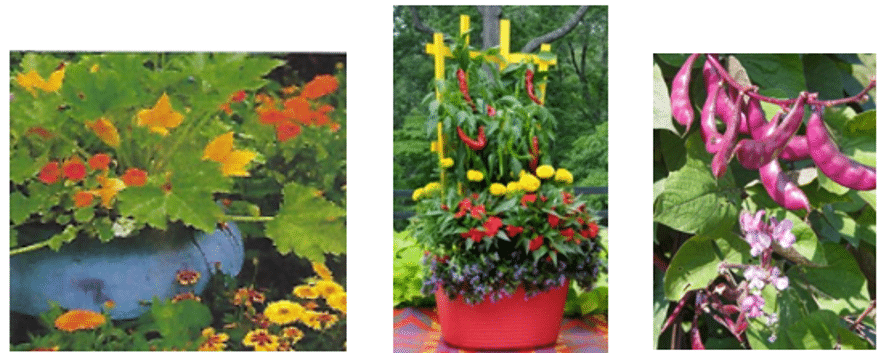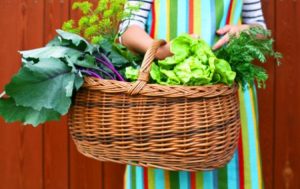
April Newsletter
April Gardening in the Greater Jacksonville Beaches area!
- What To Plant
- What To Do
- Plant Focus: ‘Alice’ Oakleaf Hydrangea
- Plant Focus: ‘Angel Red’ Pomegranate
- Patio Gardening
Now that April has arrived, the threat of a frost or freeze should be behind us. We can begin to fully embrace warm season plants and practices. This means bringing in tropicals, warm season vegetables and gearing up for more pests! Even in warm Florida the landscape changes and there is more of a variety of flowering plants. If you’re a little behind starting your vegetables and herbs, you can always refer to the March newsletter for some guidance CLICK HERE!. For help with developing any of your landscape, contact us to inquire about a landscape consultation. We can help with any size project, whether we create a complete master plan, or you simply need guidance on your next DIY project.
1/2 OFF ALL CONSULTATIONS!
(OFFER EXPIRES APRIL 15TH!)
Call us at 904-289-2161!
CLICK HERE FOR CONSULTATION FORM!
WHAT TO PLANT
Houseplants: These can be grown anytime. We currently have a great selection of plants kept to enhance your indoor areas, including air plants, hoya, succulents, bromeliads, African violets, calla lilies, ferns, ZZ plants, orchids, palms, dracaena, ficus and more. There’s a plant for every light level in your home.
Annuals (Or Grown As Annuals): Remove declining violas and pansies. Petunia and supertunia, alyssum (Lobularia), dianthus, lobelia, and snapdragons can still be planted to enjoy now but will probably only last until June when the heat moves in. If supertunias, petunias and alyssum are planted so they receive afternoon shade or in moveable containers, then these can often be babied through the hot season until they can proliferate again in the fall. Also continue growing dusty miller, gazania, verbena, nemesia, celosia, marguerite daisy and geraniums. Any of the warm season flowers can now be planted. Add helichrysum, bacopa, marigold (Tagetes), coleus, sunpatiens, zinnia, begonia, melampodium, portulaca and sweet potato vine when available. Trailing torenia is particularly good to plant now with sustained flowering through the summer. It also doesn’t require, and does better without, full sun.

Perennials: Most perennial types can be planted now, even most of the cold-tender tropical ones. Some of the great tropicals we grow here seasonally or with occasional protection are variegated shell ginger, mandevilla, ixora, croton, cordyline, colocasia, stromanthe, bougainvillea and bird of paradise. Many perennials have very long bloom times, including blue daze, salvia, pentas, beach sunflower, gaura, bush daisy, hibiscus, yarrow, plumbago, firecracker grass (Russelia), firespike (Odontonema), bulbine, shrimp plant (Justicia), cigar plant (Cuphea), canna lily, gerbera daisy and lantana. Native plants like stokes aster, coneflower, black-eyed susan (Rudbeckia), blanket flower (Gaillardia), tickseed (Coreopsis) and milkweed (Asclepias) are good choices for a more natural landscape and to support wildlife. It’s a good time to install groundcovers and border plants like Blueberry flax (Dianella) and Asiatic jasmine. Also, many bulbs can be planted at this time, particularly crinum, caladium, canna,and agapanthus. Amaryllis bulbs and poinsettias purchased during the holidays can be planted in the landscape. See our handout on Amaryllis care for more information. CLICK HERE! Poinsettias can be planted out now. Trim fading bracts and choose a spot with 3-6 hours of sun that will not receive artificial light at night.
Other perennials which can be grown a little while longer before it becomes hot include foxglove, hollyhock, dahlias and delphinium.

Trees and Shrubs: Many varieties of azalea will be blooming this month. Some of the most reliable azaleas to grow here are the Southern Indica hybrids – Duc de Rohan, Formosa, George L. Taber, Mrs. GG Gerbing, and Southern Charm. Other fine choices are Firebush (Hamelia), princess flower (Tibouchina), loropetalum, duranta, buddleia, bottlebrush, Indian hawthorn, redbud, Carolina silverbell (Halesia), fringetree (Chionanthus) and St. Lukes plum. In early April satsuma, grapefruit, orange and other citrus can be planted. We are growing some exciting edible shrubs to complement your Grow Your Own gardening. Blueberry ‘Misty’ and ‘Jewel’, Blackberry ‘Natchez’, Raspberry ‘Nantahala’, Black Mission Fig, culinary ginger, goji berry, turmeric and eventually ‘Southern Jewel’ grape will be available.
Lawn: Sod can be planted at almost any time of year, but better when it is actively growing in spring. Summer heat can be stressful but there is usually more rain during this time also. If your lawn failed previously in an area, make sure the best variety is installed for that location and do a soil test. Stagger pieces of sod and fit closely together. Wait 3-4 weeks before mowing and one to two months before fertilizing. If planting plugs, space 6-12 inches on center and don’t mow for at least 2-4 weeks or until firmly rooted, and don’t fertilize until they’ve grown together. Water sod and plugs lightly but frequently for the first month. Don’t apply a pre-emergent herbicide at least 2-4 months before sodding or plugging. Bahiagrass, centipedegrass and bermudagrass can be started with seed by April. St. Augustinegrass is not an option for seeding.
Vegetables and Herbs: A few cool season vegetables can still be grown this month for a short period, like swiss chard, but this is mainly the time to start the warm season crops. Set out sweet potato slips, tomato, pepper, eggplant and cucumber plants. Plant seeds of cantaloupe, corn, southern peas, squash, watermelon, snap beans, pole beans, lima beans, and okra. Eggplant, melons, peppers and corn need 90 days of warm weather to mature so plant these as early as possible. See our handout Planting Guide for North Florida Vegetables, for vegetable growing information. CLICK HERE!
Most of the herbs you would grow here in North Florida can be started this time of year. Dill, cilantro/coriander, parsley, garden sage, thyme, mint, chives, rosemary, oregano/marjoram, fennel, and Mexican tarragon can now be joined by cold-sensitive basil. You may also want to try nasturtium for its pretty flowers and unusual leaves that add a pleasant flavor to salads, garnishes and dips. See our handout Planting Guide for North Florida Culinary Herbs for a more complete list. Also see Herbs for North Florida, for growing and usage information for many of the herbs. CLICK HERE!
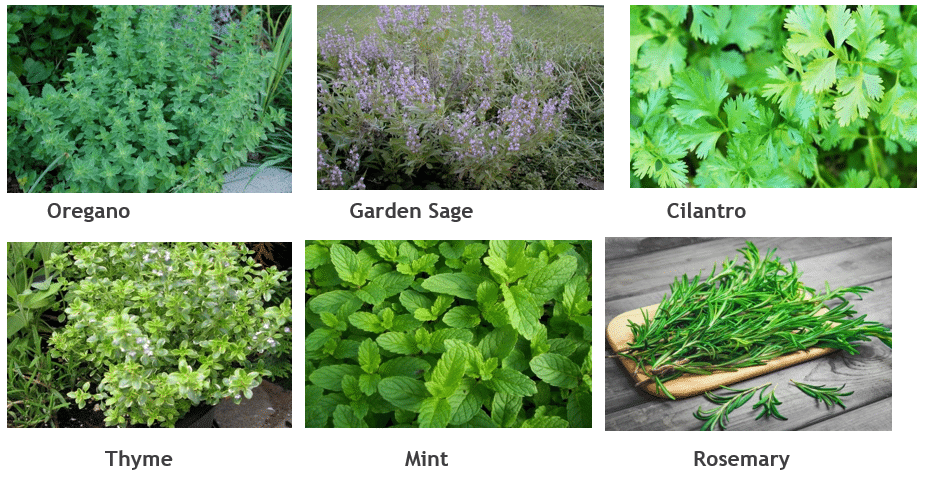
Plant Focus
There are too many exciting plants out there right now to pick just one to highlight so here are two for this month.
‘Alice’ Oakleaf Hydrangea
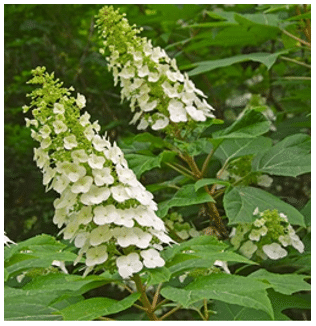
Noticing a vigorous seedling growing in a stand of native oakleaf hydrangea, plantsman Michael Dirr began propagating this superior form. It has larger flowers, better fall color and very disease resistant leaves. Mature stems exfoliate to reveal rich brown inner bark. Growth is fast but little pruning is needed to maintain its broad rounded form. Blooms are produced from the previous year’s growth. A notable feature is its tolerance of a greater amount of sun than most hydrangeas. Alice makes a great gift!
‘Angel Red’ Pomegranate
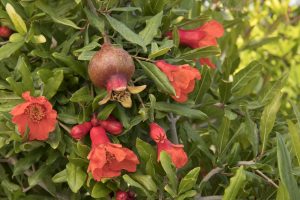
This compact growing pomegranate may be the best on the market. Its controllable stature and showy color make it an exciting addition to a courtyard or patio garden. It is easy care, and heat and drought tolerant once established (as with any plant, it may require more water in a container). Angel Red pairs well with Italian cypress and with other plants you might have in a patio garden such as lavender, bay laurel, rosemary and Meyer lemon.
What to Do
Irrigate: Last month we changed back to following a twice weekly watering schedule but only water this often if it is needed. With the current rainfall you may even want to turn off irrigation systems and water as needed. The SJRWMD allows Wednesday/Saturday irrigation for odd numbered addresses and Thursday/Sunday irrigation for even numbered addresses, outside the hours of 10 a.m. to 4 p.m. Nonresidential properties can water on Tuesdays/Fridays. Use of a micro-spray, micro-jet, drip or bubbler irrigation system is allowed any time. New plantings can be watered any time of day for 30 days post-planting and every other day for the next 30 days. Some trees may require up to 5 months of supplemental watering to establish strong roots; after the initial 2 months, this can be supplied by hand watering. It’s a good idea to check your sprinkler system for any breaks or misaligned spray heads at least monthly.

Mow: As temperatures rise and grass growth increases, frequent mowing produces a strong lawn. Mowing will remove some flowering stalks of annual weeds and make weeds less noticeable. This time of year, you may want to bag your clippings so winter annual weed seeds aren’t distributed on the lawn. Never remove more than 1/3 of the leaf blade at a time and mow
to the highest recommended height to support root growth. Here are the recommended mowing heights for several N. Florida grasses: Bahiagrass at 3-4″, Zoysiagrass coarse textured varieties at 3-4″ and fine textured at 1-2″,Centipedegrass at 1½ to 2½”, Seashore Paspalum at 1½ to 2″, and St. Augustinegrass at 2½ to 3″ but up to 4″ in the shade with the standard varieties.
Fill Lawn: Fill in low spots in your lawn with quality sterile sand mixed with organic matter, an inch or two at a time. As the grass grows into this, repeat with another 1-2″ layer until the low level is even with existing ground.
Prune: Continue to deadhead old blooms on annuals. Prune spring flowering shrubs and trees such as azalea, dogwood, redbud, Japanese magnolia, spiraea and loropetalum after they finish blooming. Remove dead fronds and old flowering parts from palms. Remove fruit from newly planted trees to help establish their roots and shoots. On established peaches and nectarines, thin to space fruit about 6-10″ apart when the fruit is about the size of a nickel. Trim tropical plants that may have suffered winter damage(for example, crotons, jatropha, hibiscus, and tibouchina). If severe enough, these may need pruning close to ground level, but most will grow back. Firebush, hibiscus and salvia also benefit from a trim.
It’s a good idea to sterilize your pruning tools with a disinfectant, between plants. Although a chlorine solution is often recommended, bleach is corrosive to metals and pitted pruners will harbor more microbes that the disinfectant can’t reach. Bleach remaining on the pruners is also damaging to plant tissue.Use Lysol instead – it is minimally corrosive and extremely effective against pathogens.
Harvest: Continue to harvest citrus as it ripens, herbs as needed and any remaining cool season crops, especially if they begin to bolt.
Clean Beds: Remove declining violas and pansies. Remove old camellia and azalea blossoms from the ground to minimize the spread of disease. Once the soil has warmed, rake up old mulch that hasn’t decomposed and dead foliage, and add 2-3″ fresh mulch. You may want to wait on adding mulch if you are looking for volunteers to come up from seed. Finish by renewing a clean edge around your beds with a flat shovel blade.
Mulch: The ground should have warmed sufficiently by now so that mulching won’t interfere with the warming process. Mulch new plants after planting. Apply a light cover around new vegetable transplants, and seedlings after they germinate. A 2-3″ layer of mulch moderates soil temperatures, retains soil moisture, reduces erosion and weeds, and adds organic matter to the soil as it decomposes. Mulch also creates an attractive unified look to highlight your plantings. Florida’s warm and often wet weather can lead to rapid breakdown of mulch.
Fertilize: This would be a good time to perform a soil test for your lawn. Go to http://soilslab.ifas.ufl.edu/ESTL%20Home.asp for online instructions.
The general lawn fertilizer recommendation calls for no phosphorus – the middle number in the fertilizer formula. However there have been an increasing number of lawns showing phosphorus deficiencies (reduced growth and dark green foliage sometimes with purple lower shoots), and a soil test will show aberrancies in other nutrients and pH too.
Wait until most of your lawn has greened up for at least 3 weeks before applying fertilizer so it can process the nitrogen. You can use a fertilizer that has equal amounts of nitrogen and potassium, and no phosphorus, such as 15-0-15 or 20-0-20. To figure how many pounds of fertilizer is needed, divide 100 by the % of nitrogen (the first number in the formula) on the fertilizer bag. For 15-0-15 this would be 100 ÷ 15 = 6.67 pounds for every 1,000 sq. ft. of lawn. After applying granular fertilizer, you will need to irrigate long enough to move the granules off the leaf blades and into the soil; this should require only about ¼” of water.
The fertilizer should also have at least one third of its nitrogen as a slow release (non-water soluble) form. In the case of the 15-0-15, this would be 5% as stated on the label. It is a superior, environmentally sound slow release fertilizer with organic nitrogen in a 16-0-8 plus 1% Mg formula for your lawn and garden.
Also useful is Nitroganic fertilizer, a milorganite-type product which contains slow release nitrogen at a lower rate and which can be applied at 10 week intervals for slow, consistent fertilizing. It is non-burning and feeds the soil while feeding the plants.
If you didn’t fertilize in March, the same fertilizer you use on your lawn can be used on other plants such as shrubs, trees, flowers and ground covers if it only contains fertilizer (not a weed and feed product). Young trees and shrubs should receive ½ to 1-pound Nitrogen per 1,000 sq. ft. Keep fertilizer away from the base of the plant. Fertilizers formulated for acid-loving plants are better for azaleas, camellias, hydrangeas (if you want the flower color to be bluer), magnolias, hollies, gardenias, dogwoods, beech and blueberries. Fertilize azaleas after their blooms fade. Blueberries should receive just a light application every other month until October, so skip this month if you fertilized them last month. There is no need to fertilize mature shrubs and trees.
Fertilize palms if you didn’t at the end of March. Palms need a high potassium to nitrogen ratio plus added magnesium so an 8-2-12 fertilizer with 4% magnesium works well. Herbs and vegetables will benefit from a slow/continuous release organic fertilizer applied every 3 to 4 weeks (herbs at half strength). If you’ve built your soil following the instructions for preparing a raised garden in last month’s newsletter, you may not need to fertilize all season. In general, even though it’s a little costlier, try to use a slow release fertilizer or fertilizer with at least 30% as a slow release component. These feed lawns and plants more consistently and lessen pollution.
Control Weeds: Many existing lawn weeds this time of year are winter annuals about to flower and die. Mow regularly removing no more than 1/3 of the leaf blade and bag the clippings to remove weed flowers before they go to seed. Avoid the use of post-emergent herbicides during spring green-up. After new turf growth begins, if a post-emergent herbicide is needed, you can use a Weed and Feed product formulated for your lawn type to simultaneously apply both a fertilizer and herbicide, such as Fertilome Weed-Out Plus Lawn Fertilizer. Fertilome Weed Free Zone is a post-emergent herbicide for broad leaf weeds useful in 45-90°F temperatures. Fertilome Selective is useful for spot treatment. To control nut-sedge and dollar weed, make sure you’re not creating favorable conditions by over-watering your lawn. Always choose an herbicide that lists your lawn type on the label and follow instructions carefully as they can vary.
Monitor and Control Insects and Disease: Continue to monitor pests and disease on houseplants, lawns and gardens. A dose of insecticidal soap or Neem Oil (combats insects, mites and fungus) may be needed on houseplants.
Fungal disease can occur almost any time of year, especially if the landscape is over watered or watered at the wrong time of day. Bonide Infuse Systemic Disease Control can prevent and control fungal growth.
Watch for discolored areas in lawns, which may be a sign of disease. Large Patch is a fungal disease that can still be a problem in warm season grasses this time of year. Treated lawns will return to a healthy appearance once new growth begins.
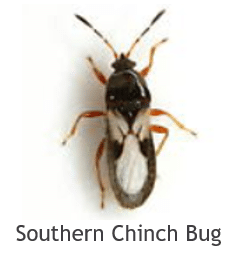
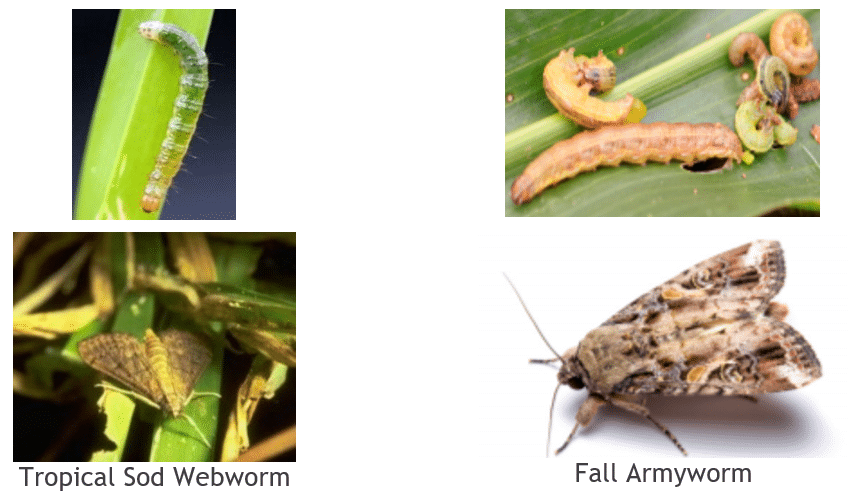
The major lawn pests active this time of year are Southern Chinch Bug, Tropical Sod Webworm and Fall Armyworm. Chinch bugs suck the juices from St. Augustinegrass at or just below the soil level. Injured plants look stunted, yellowed, wilted, or dead. Yellowish to burnt-brownish patches are often first noticed along sidewalks or in poorly-irrigated areas. To help control the problem, limit nitrogen fertilizer and reduce thatch thickness to minimize the bug’s habitat.
Newly hatched larvae of tropical sod webworm skeletonize grass blades while older larvae chew on grass blades near soil surface. Small patches of grass may look ragged and irregular. The adult moth does not cause damage but the life cycle from egg to adult only requires 5-6 weeks at 78°F.
Fall armyworm caterpillars skeletonize grass blades then later create bare spots. Younger caterpillars are more easily controlled (both webworm and armyworm) with reduced-risk products like B.t., halofenozide and spinosad.
Bifenthrin also targets all three of these lawn pests. You can use a product like Hi Yield Bug Blaster Plus Above/Below. Rotate combination products to reduce resistant populations and spot treat when possible.
In weedy areas and open fields, Lubber Grasshoppers can begin to be a problem this time of year as the babies hatch in spring. They cause vast damage, especially to grasses and grass-like vegetation, lilies, amaryllis and plumbago. They move slowly and don’t fly so it is possible to kill them by hand-picking. They are also most vulnerable to pesticides at this stage; treat with carbaryl, bifenthrin or permethrin containing products.
Check for thrips on leaves and flowers of roses and gardenias.
Aphids feed on tender new growth. Frequently scout the vegetable garden for these insects as well as scale, caterpillars and white fly, as insects are easier to control when first noticed. Beneficial insects such as ladybug beetles and lacewing can control soft-bodied insect pests. To maximize the effectiveness of these natural enemies, provide habitat and relief from high temperatures by increasing the amount and diversity of plants in your landscape. Refer to our handout Ladybugs, for storage and release information. CLICK HERE!
Horticultural soap sprays will also control many soft-bodied insect pests, and a product such as Dipel Dust with B.t. (Bacillus thunbergiensis) is useful against caterpillars. Spinosad is particularly effective on caterpillars and thrips (also leafminers, spider mites, mosquitoes, ants and fruit flies) and lasts up to 4 weeks. Additionally, it is safe for people, beneficial insects and adult butterflies, and safe for bees once it has dried. Many insect problems require a combination of pest management products and techniques.
For some problems it is occasionally less costly and more environmentally friendly to replace infected plants with another species that would be more appropriate for the site.
Patio Gardening “Container to Table”!
Full-fledged vegetable gardens aren’t the only ways to provide food and a growing experience for your family. Even small spaces like balconies, patios and courtyards can produce enough to substantially offset your grocery purchases. It can also be done in a way that fits with the aesthetics of your outdoor living space. You can apply the same design elements for arrangements of herbs and vegetables as you would any container, to include considerations about color, texture, form, scale, repetition etc. Many vegetables and herbs have attractive features and can be successfully mixed with non-edibles to make a pleasing display.
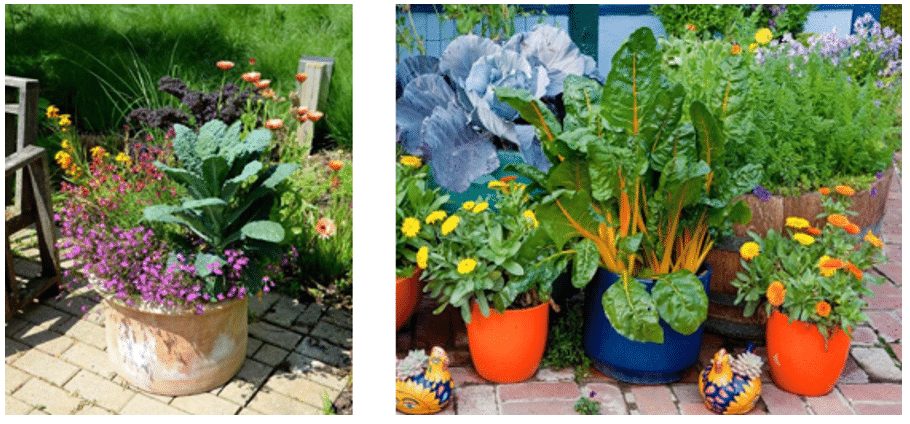
Container and Support Types: Almost any kind of container will do for herbs and vegetables as long as it has drainage holes. Black pots and metals will absorb more heat. Condensed rubber “pot risers” or ceramic feet can be used to keep the pots off the ground or flooring, so they drain better and don’t cause staining. Containers have the advantage of mobility so you can position them for optimum sun or shade as the season changes.
Strawberry jars can hold an assortment of small herbs. Fabric grow bags have their place too and are especially good for growing potatoes. They can be easily folded and stored when not in use.
Use structures such as a low wall with an interior trough to create planting opportunities for small low herbs like colorful thyme or oregano. Trellises can be fit between other structures of a patio or courtyard to provide support for climbers. Or they can be leaned against a wall or fence. A climbing bean can be planted to mix with a more ornamental climber such as a black-eyed susan vine or cold-sensitive mandevilla and both removed at the end of the season. Tee pee-type trellises made of bamboo stakes can also be positioned around a pot. Place supports when you plant so roots and stems aren’t damaged.
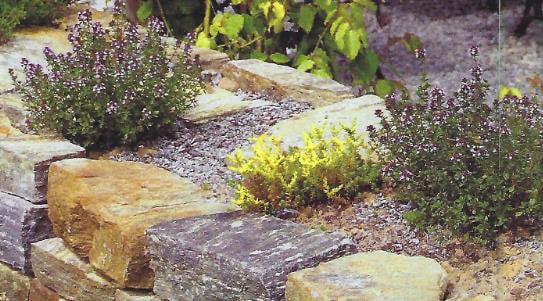
Pallets can be lined with weed cloth, filled with light weight soil and planted with small annuals, lettuces or herbs. Once seeds have germinated and established for 2-3 weeks or transplants have grown in for a week, the pallet can be leaned and made more vertical to take up less space.
Window boxes are an option too, for small to medium plants like parsley, basil and cilantro, whether they’re on your house, balcony or deck railing. Cherry tomatoes and strawberries can be grown in hanging baskets. An iron basket of nasturtiums on a gate is quaint. Even gutters can be configured to a certain length, painted and drainage holes added for an unusual but useful herb garden.
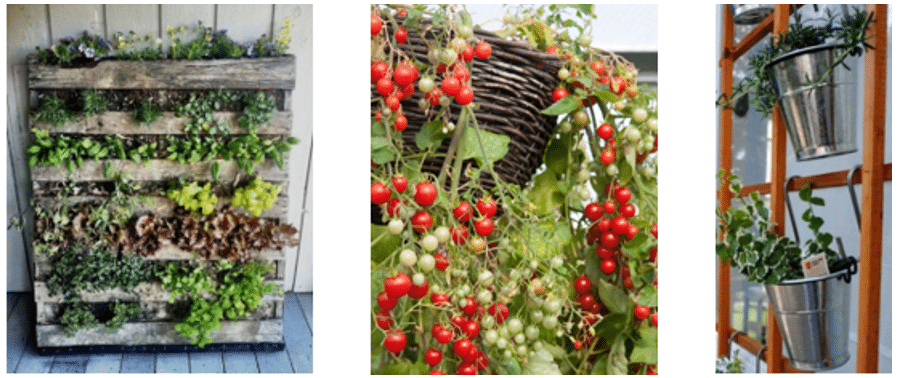
How to Grow: The soil mix and moisture level are probably the two most important considerations for container growing. The soil should be well draining. If you created the “square foot gardening mix’ for a raised planter earlier this spring, this same formula can be used – 1/3 peat moss to 1/3 vermiculite and 1/3 compost. Alternatively, others have used 2 parts potting soil to 1-part compost and 1-part peat or vermiculite. Fertilize with a slow release organic fertilizer at planting and then beginning about a month later apply soluble liquid fertilizer every 1-2 weeks using a 15-30-15 formula for fruiting vegetables and root crops, and a 20-20-20 formula for leafy vegetables. Herbs should instead be followed with minimal fertilizer as heavy applications will produce large plants with reduced flavor and aroma.
See below for recommendations of container size. The minimum soil depth for most herbs and greens is about 6 inches, but a larger pot is easier to keep well-watered. Most vegetables need about a 5-gallon container. Save the largest containers for climbers that need a sturdy trellis, such as vining beans, vine tomatoes, Malabar spinach, cucumbers, peppers, squash and melon. Use self-watering pots and automatic drip waterers where possible to reduce your maintenance.
To maximize space, you can plant root crops, low growers and climbers in the same pot. Some low growers like lettuces would prefer the part shade provided by the taller plants.
Start beans, corn, carrots, radishes, parsley, dill, fennel, borage, cilantro, chervil and nasturtium from seeds sown directly into the pot. If you use transplants of bunching onions, okra, melons and squash, take extra care in handling them.
Group plants with similar sun and moisture needs.
Because of its aggressive growth, mint is usually best grown in a pot by itself.
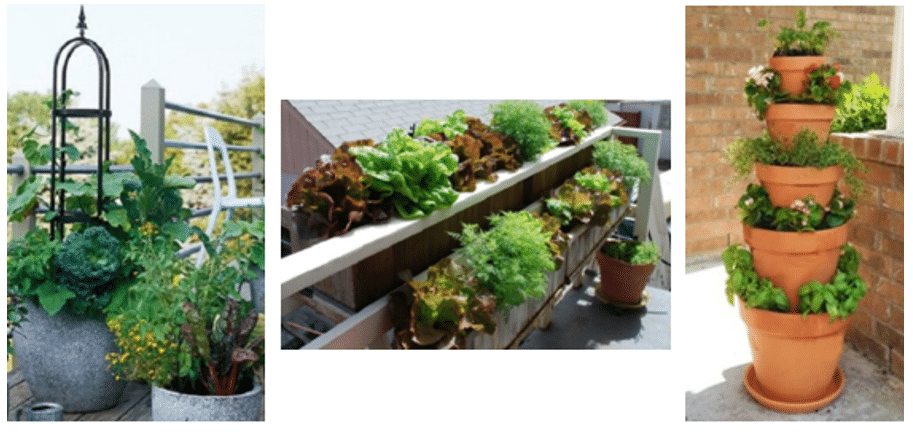
Plant Suggestions: Almost any herb can be grown in a container. The following vegetables are easy, productive choices for container gardening:
Asian Greens – such as Bok Choy. Use a container that is at least 20 inches deep by 12 inches wide per plant.
Beans – need a pot that is minimum 12 inches deep / 5-gallon capacity, and a strong trellis structure for support. A larger pot would allow additional plants like kale and celery to grow alongside. There are bush varieties that don’t require support.
Beets – use a 2 to 5-gallon container.
Carrots – container size (6 – 15 inches deep) may vary according to the carrot type you’re growing and planting depth it requires. It’s best to grow the shorter varieties such as Thumbelina or Short ‘N Sweet. Direct seed into a 2 to 5-gallon container. Thin carrot seedlings (when they’re 2 inches tall) to about 2 – 3 inches apart.
Cucumber – 2 transplants per 5-gallon container. There are bush varieties that don’t require support.
Edible Flowers – besides being edible and useful in dishes from soups to sauces, stir fry, salads, teas and even ice cream, these flowers can be used to brighten arrangements: marigolds, calendula, viola, nasturtium, rose petals, hibiscus, citrus blossoms and many of the blossoms of herbs typically grown.
Eggplant – one eggplant per 5-gallon container, at least 12 inches deep.
Garlic – choose a pot that is at least 6-8 inches deep and as wide as possible; you’ll need to leave 5-6 inches of space between each clove you plant.
Kale – can be grown in small sized pots. Each plant requires at least 6 inches of space.
Kohlrabi – 3 transplants per 5-gallon container.
Lettuce – one transplant per 1-gallon container. Choose a wide planter rather than deep; six inches deep is fine. When planting, make sure to leave at least four inches between each plant. Leaf lettuces can be grown more closely than head lettuces. You can harvest leaf lettuce multiple times throughout the (cool) growing season.
Okra – dwarf okra varieties are more suitable for containers. Pot should be at least 3 gallons in size. Ideally, a 5-gallon pot that is 10-12 inches deep and similar in diameter would be better. Best to choose a black colored pot as okra loves heat.
Onion – in a 1 gallon or larger container, thin to 2 inches between green onions and 6 inches between bulb onions.
Peas – direct seed into a 5-gallon container and thin to 5 inches apart. Choose a dwarf or bush type variety and do regular and frequent watering as peas prefer slightly moist soil.
Peppers and chilies – a large pot that is at least 12 inches deep and 16 inches across is optimum, or a 5-gallon container. It may require a cage or stick for support.
Radish – in a 2 gallon or larger container, thin to 3 inches apart. Can also grow them in small and wide pots. A planter that is just 6 inches deep is enough but if you want to grow larger varieties, use an 8 to 10-inch-deep pot. Allow 3 inches of space between each plant.
Spinach – in a 1 gallon or larger container, at least 6-8 inches deep, space 3 inches apart.
Summer squash – summer squashes (Zucchini) are more productive than winter squashes. Plant two transplants per 5-gallon container. There are bush varieties that don’t require support.
Swiss Chard – 4 plants per 5-gallon container. Each plant requires at least 6 inches of space.
Tomatoes – one transplant per 5-gallon container, at least 20 inches across for standard and vining types. The easiest to grow in containers are dwarf varieties of the determinate (reach a certain size and stop growing) type. Big Boy, Bush Champion, Early Girl Bush, and Window Box Roma are just a few of the many choices. They need little to no support. Also grow cherry
tomatoes as they are very high yielding with long staying power.
Some other plants made for patio life:
‘Baby Cakes’ blackberry
‘Mini Love’ watermelon
‘Raspberry Shortcake’ raspberry
‘Angel Red’ pomegranate
Bay laurel
‘Celestial’ fig
Meyer lemon
Dwarf navel orange
Key lime
Kaffir lime
Limequat
